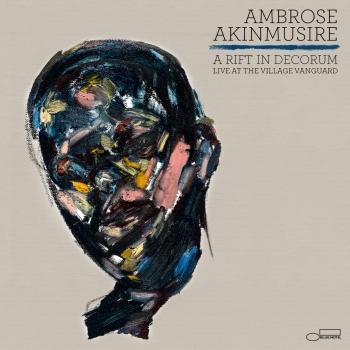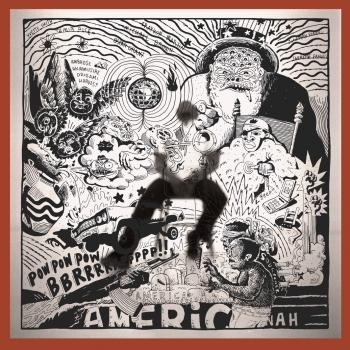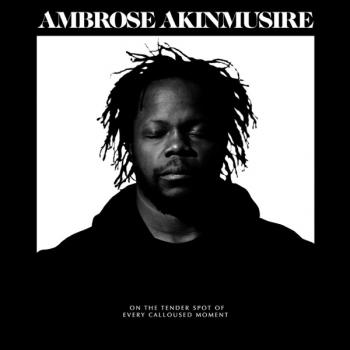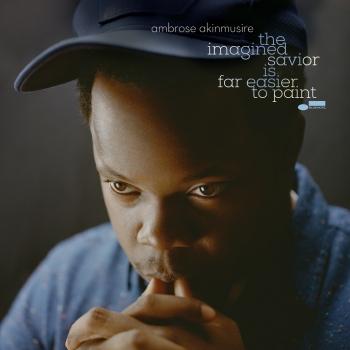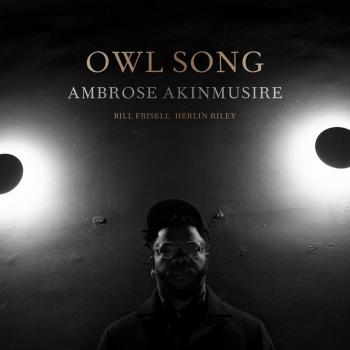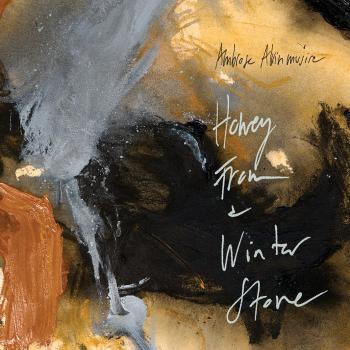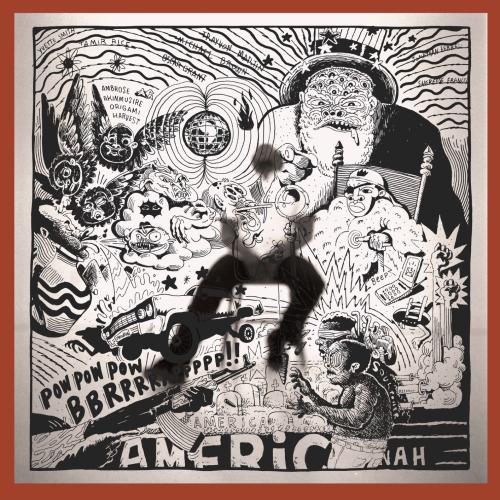
Origami Harvest Ambrose Akinmusire
Album info
Album-Release:
2018
HRA-Release:
12.10.2018
Album including Album cover
I`m sorry!
Dear HIGHRESAUDIO Visitor,
due to territorial constraints and also different releases dates in each country you currently can`t purchase this album. We are updating our release dates twice a week. So, please feel free to check from time-to-time, if the album is available for your country.
We suggest, that you bookmark the album and use our Short List function.
Thank you for your understanding and patience.
Yours sincerely, HIGHRESAUDIO
- 1 a blooming bloodfruit in a hoodie 12:57
- 2 miracle and streetfight 15:05
- 3 Americana / the garden waits for you to match her wilderness 10:41
- 4 particle / spectra 08:04
- 5 Free, White and 21 03:06
- 6 the lingering velocity of the dead's ambitions 09:55
Info for Origami Harvest
Auf seinem vierten Blue-Note-Album betritt der gefeierte Trompeter Ambrose Akinmusire abenteuerlustig musikalisches Neuland. “Origami Harvest” ist eine überraschend in sich geschlossene Studie von Kontrasten, in deren Verlauf Akinmusire mit dem New Yorker Mivos-Streichquartett und dem experimentellen Art-Rapper Kool A.D. (Das Racist) zeitgenössische Klassik und dekonstruierten Hip-Hop einander gegenüberstellt, aber auch immer wieder auf die Gebiete des Jazz, Funk, Spoken Word und Soul ausbricht. Zur Seite steht Akinmusire dabei außerdem seine eigene Band mit dem Pianisten Sam Harris, Drummer Marcus Gilmore und Saxophonist Walter Smith III. “Origami Harvest” entstand als Auftragskomposition für die Liquid Music Series in St. Paul und das Ecstatic Music Fest in Manhattan.
“Was ist die verrückteste Idee, die du auf Lager hast?” Mit dieser Frage von Judd Greenstein, dem Kurator des Ecstatic Music Fest, begann die Geschichte von “Origami Harvest”. Ambrose Akinmusire musste nicht lange nachdenken und antwortete postwendend: “Ich möchte ein Projekt über Extreme machen und Dinge, die scheinbar gegensätzlich sind, direkt nebeneinander stellen.”
Thematisch ist “Origami Harvest” ein hochaktuelles Album geworden. In den Songs geht es um die derzeitige gesellschaftliche Spaltung, um die Art und Weise, wie die Politik die Menschen in den USA emotional in Geiselhaft nimmt, und um die ständig anwachsende Liste der schwarzen Leben, die durch strukturellen Rassismus beendet werden. Wie die drei vorangegangenen Blue-Note-Alben des gebürtigen Oaklanders ist auch “Origami Harvest” ein Werk auserlesener Schönheit und grandioser Kunstfertigkeit. Jeder Track ist eine Welt für sich, in der mühelos unterschiedlichste Stimmungen und Tonarten durchquert werden.
“Origami”, versucht Akinmusire den Albumtitel zu erklären, “bezieht sich auf die verschiedenen Arten, wie Schwarze, vor allem Männer, sich ‘zusammenfalten’ müssen, sei es wenn sie scheitern oder um in eine Schablone zu passen. Während ich die Musik für das Album schrieb, wurde ich außerdem Vater eines Sohnes und dachte über diese Zyklen nach, die sich wiederholen. So kam ich auf ‘Harvest’ (Ernte).”
Ambrose Akinmusire ist ein Künstler, der sich in kurzer Zeit rasant entwickelt hat. Aufgewachsen ist er in den 80ern in North Oakland. Sein Vater, der aus Lagos stammt, versorgte ihn mit einer guten Arbeitsethik und einem Stapel nigerianischer Platten. Die Mutter, in Mississippi geboren, beschallte den kleinen Ambrose wiederum mit Funkadelic und an Sonntagen mit seiner Lieblingsaufnahme: “Amazing Grace” von Aretha Franklin. Sie achtete auch darauf, dass er immer etwas zu tun hatte und nicht auf dumme Gedanken kommen konnte. Seinen Weg zur Musik fand er aber eigentlich ganz allein schon mit zwei Jahren - er konnte es einfach nicht lassen, auf dem Klavier seiner Oma herumzuklimpern. Deshalb ließen ihn seine Eltern früh Unterricht nehmen. Dann lernte er Schlagzeug und Trompete spielen, nahm an Musiklagern teil, spielte in Bands und besuchte Workshops. Obwohl es keine leichte Zeit war, sagt Akinmusire zufrieden: “Ich bin in einer sehr schwarzen, kulturell reichen, stolzen Gegend von Oakland aufgewachsen.” Einer seiner Mentoren war ein ehemaliger Black Panther.
Seine Tatkraft ist ungebrochen geblieben. Er bewies sie in seiner Highschool-Zeit, als er bei einem Workshop Steve Coleman so sehr beeindruckte, dass dieser ihn vom Fleck weg für seine gefeierte Band Five Elements engagierte. Sie verließ ihn auch nicht, als er an der Manhattan School of Music, der University of Southern California (wo er seinen Master machte) und dem Thelonious Monk Institute of Jazz (bei Herbie Hancock und Wayne Shorter) studierte. 2007 gewann er zwei der renommiertesten internationalen Jazzwettbewerbe: den Thelonious Monk International Jazz Competition und den Carmine Caruso International Jazz Trumpet Solo Competition. Kurz danach brachte Ambrose Akinmusire sein beeindruckendes Debütalbum “Prelude: To Cora” heraus. Nachdem er von Kalifornien wieder nach New York zurückgezogen war, begann er Zusammenarbeiten mit Esperanza Spalding und Jason Moran und zog die Aufmerksamkeit von Bruce Lundvall auf sich, der ihm einen Plattenvertrag bei Blue Note gab. Für das Label nahm er seither immer ambitionierte Alben auf: 2011 “When The Heart Emerges Glistening”, 2014 “The Imagined Savior Is Far Easier To Paint” und 2017 das Doppel-Live-Album “A Rift in Decorum: Live At The Village Vanguard”. Einen Gastauftritt absolvierte Akinmusire u.a. auf Kendrick Lamars “To Pimp A Butterfly”. Beim JazzFest Berlin zollte er letztes Jahr in einer viel bejubelten Auftragskomposition der Bluessängerin Mattie Mae Thomas Tribut. Teil seiner Suite “Mae Mae” waren die wenigen überlieferten Stücke, die Thomas in den 1930er Jahren im Staatsgefängnis von Mississippi geschrieben hatte.
“Origami Harvest” ist das erste Album, das Akinmusire seit seiner erneuten Rückkehr nach Oakland aufgenommen hat. Es ist jeder Beziehung ein Protestalbum, auf dem die Stimmung ständig zwischen Grauen und Hoffnung oszilliert. Der Opener “a blooming bloodfruit in a hoodie” erinnert zwar an Trayvon Martins schrecklichen Tod, wartet aber zugleich mit den leuchtendsten Tönen und eingängigsten Grooves des Albums auf. In “Americana / the garden waits for you to match her wildness”, einem Song der etwas von den repetitiven Mustern eines Steve Reich hat, versuchte Akinmusire, wie er sagt, “Zeit und Raum zu beugen“. “Ich dachte darüber nach, dass wir in dem heutigen politischen Klima keinen Raum mehr haben um anzuhalten und Atem zu holen. Es ist, als ob jemand den Weg zum Frieden in uns verstellt. Der Track verändert sich gerade so viel, dass man es nicht ignorieren kann. Man muss die Musik entweder abschalten oder sich auf sie einlassen. Ich wollte kontrollieren, wie man die Zeit verstreichen spürt.”
In dem zappaesken “Free, White And 21” knüpft Akinmusire an eine Tradition an, die er 2011 auf “When The Heart Emerges Glistening” begonnen und 2014 auf “The Imagined Savior Is Far Easier To Paint” fortgesetzt hatte: über Musik werden die Namen von Afroamerikanern verlesen, die von der Polizei oder Möchtegern-Vigilanten getötet wurden. Wenn man genau hinlauscht, hört man ihn im Hintergrund zu einem schrägen patriotischen Marschrhythmus den Spiritual “Blood-Stained Banner” pfeifen. Das Thema greift er ganz bewusst wieder auf und gesteht sogar: “Ich will, dass es irgendwie nervig wird, dass die Leute sagen: ‘Oh, er macht das schon wieder?’ Denn Tatsache ist, dass ich immer noch so fühle. Wir haben immer noch mit derselben Scheiße zu tun, mit der ich mich schon auf meinem ersten Blue-Note-Album auseinandersetzte.”
Dem Song, dessen Titel bis zu den 1950er Jahren eine populäre Redewendung war, mit der man zum Ausdruck brachte, dass man ungebunden und Herr seines eigenen Schicksals ist, geht die coole Nummer “particle/spectra” voraus, ein stark klassisches Stück, in dem er als Gast den aus Oklahoma City stammenden Soul-Sänger LmbrJck_T präsentiert. Beendet wird das Album mit dem furiosen “the lingering velocity of the dead’s ambitions”.
Es ist kein Wunder, dass Akinmusire diese abenteuerlichen Songs, nachdem er sie ein zweites Mal auf dem Ecstatic Music Fest live aufgeführt hatte, unbedingt auch aufnehmen wollte. Er fragte seine musikalischen Partner, ob sie am nächsten Tag mit ihm ins Studio gehen könnten, und zu seiner Freude sagten alle sofort zu. Es hatte ihn ein Jahr gekostet, die Stücke zu schreiben, und die Themen waren einfach zu reif und brandaktuell. “Ich habe viel über das Männliche und das Weibliche nachgedacht. Über hohe und niedrige Kunst. Freie Improvisation und kontrollierte Kalkulation. Amerikanische Ghettos und amerikanischen Wohlstand”, sagt Akinmusire. “Ursprünglich wollte ich alles so dicht zusammenbringen, dass es die Tatsache unterstreichen würde, dass zwischen diesen vermeintlichen Extremen gar nicht so viel Platz ist, wie wir denken. Aber ich weiß nicht, ob das wirklich die richtige Schlussfolgerung wäre.”
Ambrose Akinmusire, Trompete, Synthesizer, Gesang
Sam Harris, Keyboards, Piano
Walter Smith, Tenorsaxophon
Michael Aaberg, Keyboards
Kool A.D., Rap
Marcus Gilmore, Schlagzeug
Lauren Cauley Kalal, Violine
Olivia De Prato, Violine
Mariel Roberts, Cello
Victor Lowrie Tafoya, Viola
Ambrose Akinmusire
“a thrilling young trumpeter and astute bandleader [with a] unique spark in his playing” (The New Yorker), brings his artistic vision to the next level with "The Imagined Savior Is Far Easier To Paint", his second release for Blue Note Records. The album follows his acclaimed major label debut "When the Heart Emerges Glistening", which New York Times critic Nate Chinen named his #1 album of 2011, Akinmusire takes a more compositional turn on "The Imagined Savior Is Far Easier To Paint", writing 12 of the 13 tracks and producing the album himself.
While Akinmusire continues to feature his extraordinary working quintet with tenor saxophonist Walter Smith III, pianist Sam Harris, bassistHarish Raghavan, and drummer Justin Brown, he also broadens his palette by enlisting guitarist and fellow Northern California native Charles Altura. In addition, Akinmusire unveils gripping new collaborations with the OSSO String Quartet and flutist Elena Penderhughes, as well as vocalists Becca Stevens, Theo Bleckmann, and Cold Specks.
However, these encounters with strings and voices don’t at all diminish the central role of Akinmusire’s quintet, now edging toward a sextet with the addition of Altura. It’s awe-inspiring to hear the band’s energy and focus as it confronts every challenge in “As We Fight (willie penrose),” “Vartha,” “Bubbles (john william sublett)” (inspired by tap-dance legend John Bubbles), and “Richard (conduit),” a 16-minute-plus closing epic recorded live at Jazz Standard in New York City.
Also, while Akinmusire’s virtuoso trumpet is still very present on "The Imagined Savior Is Far Easier To Paint", it coexists in a larger sonic framework than before. “Composition is what I’ve been focusing on the last few years,” the trumpeter says. “I want to be able to write a song and not have it need improvisation”
Reflecting on his penchant for long and poetic album titles, Akinmusire comments: “I don’t think I’ve been able to make an album yet where one word can capture the whole vibe. Maybe eventually I will. Right now I’m drawing from so many different parts of myself, and things that are outside of myself, that it’s hard to just have one word that says, ‘This means this.’”
Akinmusire continues: “The last album was about me — about things that I was experiencing and trying to change or accept about myself. The inspiration for this album is things outside of myself: people that I know, documentaries that I’ve watched, characters that I’ve made up.” Indeed, many song titles on "The Imagined Savior Is Far Easier To Paint" have a name attached in parentheses, and some of these reflect Akinmusire’s practice of creating elaborate storylines and fictional characters as an inspiration for his writing. On "The Imagined Savior Is Far Easier To Paint" he took this in a new direction, giving each of his guest vocalists a sketch of an idea and allowing them to create their own lyrics based on that idea.
The results are astonishing, beginning with Becca Stevens’ performance on her original “Our Basement (ed)”: centered by a pulsing heartbeat of a tempo, Stevens’ words and eerie unfolding harmonies mesh with Akinmusire’s quintet and the Osso String Quartet together in a complex and beautiful arrangement. The lyrical inspiration is “ed,” a homeless man on Akinmusire’s block who managed to save a couple hundred dollars to give back to the church that feeds him on weekends.
Theo Bleckmann, without question an innovator in vocal performance, met Akinmusire at the famed music workshop in Banff, Alberta. “We were on faculty and we played a Kate Bush song,” Akinmusire recalls. “After we played we looked at each other and I was like, ‘Ok, we have to work together.’” The resulting “asiam (joan),” featuring Bleckmann with the quintet, is inspired by Joni Mitchell — specifically, Michelle Mercer’s portrait of “Joan” in her 2009 book Will You Take Me As I Am: Joni Mitchell’s Blue Period.
“Ceaseless Inexhaustible Child (cyntoia brown)” — dedicated to the imprisoned young woman at the heart of the documentary The 16-Year-Old Killer — features the dramatic “doom soul” vocals of Cold Specks, the Canadian-born, London-based singer-songwriter. “I’m a huge fan of hers,” says Akinmusire. “In June I did this tribute to Joni up in Toronto. I wrote [Cold Specks] an email asking her to be on my album, and she wrote back saying she was just about to invite me to be on her album.”
Along with the vocal tracks, there are two additional pieces with string quartet and flute, “The Beauty of Dissolving Portraits” and “inflatedbyspinning.” The former stems from Akinmusire’s influences outside of jazz: “I’m really into people like Arvo Pärt, people whose compositions tend to evolve slowly. They’re adding and taking things away in a way that you don’t notice until a certain amount of time has gone by. It’s really hard with jazz instrumentation in a quintet format to get that sort of sustain.”
With “inflatedbyspinning,” Akinmusire captures a daydream: “I had an image of women standing on a cliff spinning. One was holding a red balloon, and at the start of the spinning the balloon wasn’t inflated, but when the spinning stopped, it was inflated.” Raghavan’s broad-toned arco bass supplements the strings and flute here.
In a loose parallel to “my name is OSCAR” (dedicated to the late Oscar Grant) on his previous album, Akinmusire offers “Rollcall for Those Absent” as an overt statement on “a certain reality that you can't deny that goes on here in America and in the world: this fear of black men that causes a lot of sad stories.” The instrumentation here is wholly different from the rest of the album: Harris plays the melody on mellotron while Akinmusire plays chords and bass notes on Juno synth, and Muna Blake (the young daughter of drummer Johnathan Blake) reads aloud the names of numerous people killed by police — or by vigilante action, as in the prominent case of Trayvon Martin. “Having a young voice read the names, it’s like the beginning of life talking about the end of life,” Akinmusire says. “I wanted to capture that. In the same way, sounds that are really high and really low are like the beginning and the end.”
Born and raised in Oakland, California, Ambrose Akinmusire (pronounced ah-kin-MOO-sir-ee) was a member of the Berkeley High School Jazz Ensemble when he caught the attention of saxophonist Steve Coleman. Akinmusire was asked to join Coleman’s Five Elements, embarking on a European tour when he was just a 19-year-old student at the Manhattan School of Music. After returning to the West Coast to pursue a master’s degree at the University of Southern California, Akinmusire went on to attend the Thelonious Monk Institute of Jazz in Los Angeles, where he studied with Herbie Hancock, Wayne Shorter and Terence Blanchard.
In 2007 Akinmusire won the prestigious Thelonious Monk International Jazz Competition, decided by a panel of judges that included Blanchard, Quincy Jones, Herb Alpert, Hugh Masekela, Clark Terry and Roy Hargrove. That year Akinmusire also won the Carmine Caruso International Jazz Trumpet Solo Competition and released his debut album Prelude…To Cora on the Fresh Sound label. He moved back to New York and began performing with the likes of Vijay Iyer, Aaron Parks, Esperanza Spalding and Jason Moran. It was also during this time that he first caught the attention of another discerning listener, Bruce Lundvall, President of Blue Note Records.
Akinmusire’s Blue Note debut "When The Heart Emerges Glistening" was released in 2011 to rave reviews. The Los Angeles Times praised his “chameleonic tone that can sigh, flutter or soar,” adding that “Akinmusire sounds less like a rising star than one that was already at great heights and just waiting to be discovered.” DownBeat described his playing as “spectacular and not at all shy — muscular, driving, with a forward sound, pliant phrasing and a penchant for intervallic leaps,” concluding that “clearly something very special and personal is at work here, a vision of jazz that’s bigger than camps, broader and more intellectually restless than blowing sessions.”
This album contains no booklet.











